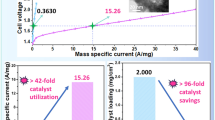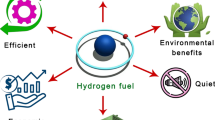Abstract
The heterogeneously porous gas diffusion layers (GDLs) in high-temperature proton-exchange membrane fuel cells (HT-PEMFCs) have not yet been comprehensively investigated. In this work, homogeneous and heterogeneous porosity models are established, and the effects of porosity on the electrical conductivity, oxygen distribution, diffusion flux, ohmic resistance, ohmic polarization, and cell performance of HT-PEMFCs are discussed. The results indicate that increasing the average degree of porosity can improve the oxygen concentration and the uniformity index of oxygen distribution in the catalytic layer. When the average porosity increases from 45 to 65%, the uniformity index increases from 80.21 to 91.93%. Porosity is inversely proportional to electrical conductivity and directly proportional to ohmic resistance. Discussions of the porosity heterogeneity reveal that the average porosity is the main factor affecting the cell performance. The optimal porosity of the GDL falls between 40% and 45%, and the gradient of porosity is small.
Graphical abstract









Similar content being viewed by others
Data Availability
The data that support the findings of this study are available from the corresponding author upon reasonable request.
References
Liu P, Fan S, Liu Y, Han X, Jin Z (2021) Three-dimensional modeling of anode-supported planar SOFC with corrugated electrolyte. J Electrochem Soc 168:104501. https://doi.org/10.1149/1945-7111/ac2974
Fan S, Ye J, Yao Q, Wang D, Yang L, Jin Z (2021) Effect of flow modes on operation characteristics of three-dimensional non-isothermal solid oxide fuel cell stack. Int J Energy Res. https://doi.org/10.1002/er.7210
Vazifeshenas Y, Sedighi K, Shakeri M (2015) Numerical investigation of a novel compound flow-field for PEMFC performance improvement. Int J Hydrogen Energy 40:15032–15039. https://doi.org/10.1016/j.ijhydene.2015.08.077
Shusheng X, Qiujie S, Baosheng G, Encong Z, Zhankuan W (2020) Research and development of on-board hydrogen-producing fuel cell vehicles. Int J Hydrogen Energy 45:17844–17857. https://doi.org/10.1016/j.ijhydene.2020.04.236
Xing L, Mamlouk M, Scott K (2013) A two dimensional agglomerate model for a proton exchange membrane fuel cell. Energy 61:196–210. https://doi.org/10.1016/j.energy.2013.08.026
Xia L (2021) Numerical study of triple-phase boundary length in high-temperature proton exchange membrane fuel cell. Short Communi 2021:1–13. https://doi.org/10.1002/er.7223
Zamel N, Li X (2008) Transient analysis of carbon monoxide poisoning and oxygen bleeding in a PEM fuel cell anode catalyst layer. Int J Hydrogen Energy 33:1335–1344. https://doi.org/10.1016/j.ijhydene.2007.12.060
Chu HS, Wang CP, Liao WC, Yan WM (2006) Transient behavior of CO poisoning of the anode catalyst layer of a PEM fuel cell. J Power Sources. https://doi.org/10.1016/j.jpowsour.2005.12.045
Wang CP, Chu H, Sen, (2006) Transient analysis of multicomponent transport with carbon monoxide poisoning effect of a PEM fuel cell. J Power Sources. https://doi.org/10.1016/j.jpowsour.2005.12.004
Heidary H, Jafar Kermani M, Khajeh-Hosseini-Dalasm N (2016) Performance analysis of PEM fuel cells cathode catalyst layer at various operating conditions. Int J Hydrogen Energy 41:22274–22284. https://doi.org/10.1016/j.ijhydene.2016.08.178
Daş E, Alkan Gürsel S, Bayrakçeken Yurtcan A (2020) Pt-alloy decorated graphene as an efficient electrocatalyst for PEM fuel cell reactions. J Supercrit Fluids. https://doi.org/10.1016/j.supflu.2020.104962
Bie K, Fu P, Liu Y, Muhammad A (2020) Comparative study on the performance of different carbon fuels in a molten carbonate direct carbon fuel cell with a novel anode structure. J Power Sources 460:228101. https://doi.org/10.1016/j.jpowsour.2020.228101
Kang S, Zhou B, Jiang M (2017) Bubble behaviors in direct methanol fuel cell anode with parallel design. Int J Hydrogen Energy 42:20201–20215. https://doi.org/10.1016/j.ijhydene.2017.06.149
Tiss F, Chouikh R, Guizani A (2014) A numerical investigation of reactant transport in a PEM fuel cell with partially blocked gas channels. Energy Convers Manag 80:32–38. https://doi.org/10.1016/j.enconman.2013.12.063
Perng SW, Wu HW, Wang RH (2014) Effect of modified flow field on non-isothermal transport characteristics and cell performance of a PEMFC. Energy Convers Manag 80:87–96. https://doi.org/10.1016/j.enconman.2013.12.044
Bao Y, Gan Y (2020) Roughness effects of gas diffusion layers on droplet dynamics in PEMFC flow channels. Int J Hydrogen Energy 45:17869–17881. https://doi.org/10.1016/j.ijhydene.2020.04.228
Athanasaki G, Wang Q, Shi X, Chauhan N, Vimala V, Cindrella L et al (2021) Design and development of gas diffusion layers with pore forming agent for proton exchange membrane fuel cells at various relative humidity conditions. Int J Hydrogen Energy 46:6835–6844. https://doi.org/10.1016/j.ijhydene.2020.11.187
Xia L, Ni M, He Q, Xu Q, Cheng C (2021) Optimization of gas diffusion layer in high temperature PEMFC with the focuses on thickness and porosity. Appl Energy 300:117357. https://doi.org/10.1016/j.apenergy.2021.117357
El-Kharouf A, Mason TJ, Brett DJL, Pollet BG (2012) Ex-situ characterisation of gas diffusion layers for proton exchange membrane fuel cells. J Power Sources 218:393–404. https://doi.org/10.1016/j.jpowsour.2012.06.099
Xing L, Wang Y, Das PK, Scott K, Shi W (2018) Homogenization of current density of PEM fuel cells by in-plane graded distributions of platinum loading and GDL porosity. Chem Eng Sci 192:699–713. https://doi.org/10.1016/j.ces.2018.08.029
Nabovati A, Hinebaugh J, Bazylak A, Amon CH (2014) Effect of porosity heterogeneity on the permeability and tortuosity of gas diffusion layers in polymer electrolyte membrane fuel cells. J Power Sources 248:83–90. https://doi.org/10.1016/j.jpowsour.2013.09.061
Chu H, Sen, Yeh C, Chen F (2003) Effects of porosity change of gas diffuser on performance of proton exchange membrane fuel cell. J Power Sources 123:1–9. https://doi.org/10.1016/S0378-7753(02)00605-5
Zhang Y, Verma A, Pitchumani R (2016) Optimum design of polymer electrolyte membrane fuel cell with graded porosity gas diffusion layer. Int J Hydrogen Energy 41:8412–8426. https://doi.org/10.1016/j.ijhydene.2016.02.077
Yang P, Wang Y, Yang Y, Yuan L, Jin Z (2021) Effects of gas diffusion layer porosity distribution on proton exchange membrane fuel cell. Energy Technol. https://doi.org/10.1002/ente.202001012
Sun X, Xie X, Wu S, Liu Z, Zhou X, Jiao K (2021) Investigation of metal foam porosity and wettability on fuel cell water management by electrochemical impedance spectroscopy. Int J Green Energy. https://doi.org/10.1080/15435075.2021.1880908
Jaber TJ, Jaralla R, Sulaiman MA, Bourouni K (2017) Numerical study on high temperaturePEM fuel cell (HTPEMFC). J Power Sources 2017:26–28
Jha V, Hariharan R, Krishnamurthy B (2020) A 3 dimensional numerical model to study the effect of GDL porosity on high temperature PEM fuel cells. Int J Heat Mass Transf 161:120311. https://doi.org/10.1016/j.ijheatmasstransfer.2020.120311
Coker AK (2007) Physical properties of liquids and gases. Ludwig’s Appl Process Des Chem Petrochem Plants. https://doi.org/10.1016/b978-075067766-0/50010-5
Li S, Sundén B (2017) Three-dimensional modeling and investigation of high temperature proton exchange membrane fuel cells with metal foams as flow distributor. Int J Hydrogen Energy 42:27323–27333. https://doi.org/10.1016/j.ijhydene.2017.09.014
Ubong EU, Shi Z, Wang X (2009) Three-Dimensional Modeling and Experimental Study of a High Temperature PBI-Based PEM Fuel Cell. J Electrochem Soc 156:B1276. https://doi.org/10.1149/1.3203309
Osanloo B, Mohammadi-Ahmar A, Solati A (2016) A numerical analysis on the effect of different architectures of membrane, CL and GDL layers on the power and reactant transportation in the square tubular PEMFC. Int J Hydrogen Energy 41:10844–10853. https://doi.org/10.1016/j.ijhydene.2016.04.228
Sun P (2011) Modeling studies and efficient numerical methods for proton exchange membrane fuel cell. Comput Methods Appl Mech Eng 200:3324–3340. https://doi.org/10.1016/j.cma.2011.08.007
Weltens H, Bressler H, Terres F, Neumaier H, Rammoser D (1993) Optimisation of catalytic converter gas flow distribution by CFD prediction. SAE Tech Pap. https://doi.org/10.4271/930780
Bhattacharya D, Mukhopadhyay J, Biswas N, Basu RN, Das PK (2018) Performance evaluation of different bipolar plate designs of 3D planar anode-supported SOFCs. Int J Heat Mass Transf 123:382–396. https://doi.org/10.1016/j.ijheatmasstransfer.2018.02.096
Acknowledgments
The authors gratefully acknowledge the financial support for this project from the National Natural Science Foundation of China (No. 21676257). The authors declared that there is no conflict of interest.
Author information
Authors and Affiliations
Corresponding author
Additional information
Publisher’s Note
Springer Nature remains neutral with regard to jurisdictional claims in published maps and institutional affiliations.
Rights and permissions
Springer Nature or its licensor holds exclusive rights to this article under a publishing agreement with the author(s) or other rightsholder(s); author self-archiving of the accepted manuscript version of this article is solely governed by the terms of such publishing agreement and applicable law.
About this article
Cite this article
Han, X., Liu, P., Fan, S. et al. Numerical study of heterogeneous porosity in gas diffusion layers of high-temperature proton-exchange membrane fuel cells. J Appl Electrochem 52, 1733–1746 (2022). https://doi.org/10.1007/s10800-022-01746-2
Received:
Accepted:
Published:
Issue Date:
DOI: https://doi.org/10.1007/s10800-022-01746-2




